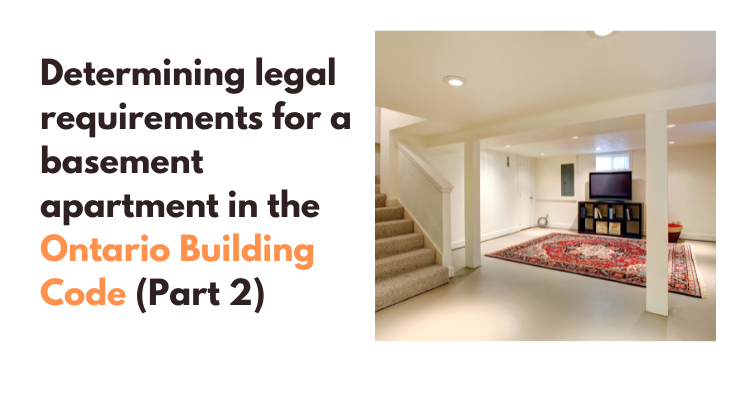You might be wondering what makes a basement apartment legal in Ontario. To legalize a basement apartment in Ontario, you must meet the Ontario Building Code requirements. Equally as important is the strict adherence to the local zoning bylaws. Legalizing a basement apartment in Ontario requires both following the strict requirements of the Ontario Building Code as well as ensuring that all local zoning bylaws are strictly observed. To properly complete this process, it is important to have a basic understanding of all relevant building codes and bylaw regulations.
These regulations govern aspects such as fire safety, habitability, indoor comfort, energy efficiency, plumbing systems, egress windows and other safety measures. Likewise zoning bylaws set out requirements such as the minimum size of living spaces, parking and other requirements that determine the appearance of a neighborhood. It is important to know that zoning bylaws can vary significantly depending on which city or region of Ontario you plan to add a secondary unit. However, fulfilling these standards is necessary for ensuring a safe and healthy environment for the occupants and community. So let’s clarify the difference between the zoning bylaw and building code
How does the Municipal Zoning Bylaw differ from the Ontario Building Code?
It can be confusing if you are new to this information, so make it brief.
The Municipal Zoning Bylaw sets the rules and regulations for land use in a community. This includes specific requirements like the type of housing that can be built, height restrictions, minimum lot sizes, setbacks from property lines, number of parking spots and buffer zones between lots.
The Ontario Building Code on the other hand establishes provincial standards for safety related to construction projects such as fire protection systems, stair and handrails, window sizes, natural light required, egress, escapes and exits. The Building Code is a comprehensive document that also includes accessibility provisions and energy efficiency requirements. It’s important to note that both the Zoning Bylaw and Building Code are subject to change depending on local needs or updated information from other sources.
How do I add a new second unit in Ontario to an existing basement?
This process varies from the process of establishing the legal status of a basement apartment that exists. To add a second unit to an existing basement, you must first apply the compliance path for the property. There are two paths from a single-family house into a two-unit dwelling with a basement apartment.
The Ontario building code establishes these paths based on the age of the house being converted.
First Compliance Path: Existing building more than 5 years old
If a house was built before 2018, (we’re in 2023) the house would be able to comply with the OBC alternative compliance section – Part 11 for much of the required health and safety standards. These requirements can be less restrictive as it would be impractical to alter the systems of the house. This could serve as an advantage when converting a basement into an apartment within a two-unit dwelling.
The following permit will be required:
- Building Permit
- ESA Permit
- Occupancy Permit
Second Compliance Path: Existing Building up to 5 years old
If a house was built after 2018, (we’re in 2023) the house would need to comply with the OBC section – Part 9 for much of the required health and safety standards. These requirements can be more restrictive but would be necessary to alter the systems of the house. This could serve as an advantage when converting a basement into an apartment within a two-unit dwelling as the unit would meet the highest minimum code requirements.
The following permit will be required:
- Building Permit
- ESA Permit
- Occupancy Permit
How does the Ontario Building Code define a House versus a Building?
To most people, a house and a building have no distinct difference. And so may even use the words interchangeably. But the OBC defines each so let’s take a look at both.
Building: “ Building means (a)a structure occupying an area greater than ten square meters consisting of a wall, roof and floor or any of them or a structural system serving the function thereof including all plumbing, works, fixtures and service systems appurtenant thereto,
(b)a structure occupying an area of ten square meters or less that contains plumbing, including the plumbing appurtenant thereto,
(c)plumbing not located in a structure,
(c.1)a sewage system, or
(d)structures designated in the building code; (“bâtiment”)”
“House: House means a detached house, semi-detached house or row house containing not more than two dwelling units.”
When does a House become a Building?
This may seem confusing but based on the OBC definitions of a house and a building. However, if is a building that contains a maximum of 2 dwelling units. Once the house is designed to have 3 or more dwelling units, it is then defined as a building to apply the parts of the Ontario Building Code. In other words, a single detached, semi-detached, townhouse or duplex is considered a house and a triplex, fourplex, or multiplex is considered a building. So at Property Pathways, we define these assets as Single Houses, Multiplex Houses and Multiplex Buildings.
What are the Parts of the Ontario Building Code?
Here are the basics on how to review the OBC for multiplex houses and buildings. First, determine whether the property existed for more than 5 years. If it did, then only some parts of Part 9 apply. If it didn’t, then you have to apply all Parts of Part 11 and section 9.40 applies. Structural requirements may need to comply with Part 4 as well. If the property is less than 5 years old, then safety requirements are more stringent. The owner and the builder will need to review and comply with OBC Parts 3, 4 and 9 for multiplex houses or buildings. Additionally, Part 12 of the OBC may apply if an addition is proposed. To review these parts, you may need to hire an engineer or a qualified architect who can properly evaluate them.
Get a free copy of the latest version of the Ontario building code here and begin reviewing the information to determine if the property is a multiplex house versus a multiplex building. Also, you should consider the age of the property and whether or not additions are proposed. This will help guide your decisions on which parts of the OBC to apply to ensure that the building is up to code. Lastly, always hire a qualified engineer or architect who can properly evaluate your project and provide feedback on which requirements need to be met for it to be safe and compliant. Doing so will save you time, money, and potential legal liabilities in the future.
Read More!
Missed part one of our four-part series on legalizing basement apartments? Click here to catch up on the first installment. Click here to access part three if you’re interested in learning about the importance and implementation of building code requirements for legalizing basement apartments in Ontario.


